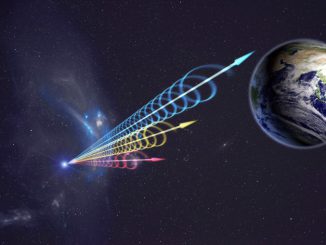
fast radio bursts





Mapping the cosmic web with fast radio bursts
Fast radio bursts, or FRBs, are mysterious flashes of radio waves originating outside our Milky Way galaxy. A team of scientists, jointly led by Caltech postdoctoral scholar Vikram Ravi and Curtin University research fellow Ryan Shannon, has now observed the most luminous FRB to date, called FRB 150807.

Fast radio bursts born in cosmic cataclysms
Fast radio bursts (FRBs) were first discovered in 2007, and in the years since radio astronomers have detected a few dozen of these events. Researchers have found that these mysterious “cosmic whistles” can release a billion times more energy in gamma-rays than they do in radio waves, rivalling supernovae in their explosive power.

Fast radio burst “afterglow” was actually a flickering black hole
Fast radio bursts (or FRBs) are brief yet powerful spurts of radio energy lasting only a few milliseconds. They were first identified in 2007 and their source has remained a mystery. New research shows that the radio emission believed to be an afterglow from FRB 150418 actually originated from a distant galaxy’s core and was unassociated with the FRB.

Repeat fast radio bursts detected from same sky location
Astronomers for the first time have detected repeating short bursts of radio waves from an enigmatic source that is likely located well beyond the edge of our Milky Way galaxy. The findings indicate that these “fast radio bursts” come from an extremely powerful object which occasionally produces multiple bursts in under a minute.

‘Fast Radio Burst’ sheds new light on origin of these extreme events
Fast radio bursts (FRBs), brief yet brilliant eruptions of cosmic radio waves, have baffled astronomers since they were first reported nearly a decade ago. Though they appear to come from the distant universe, none of these enigmatic events has revealed more than the slimmest details about how and where it formed, until now.

Mysterious energy bursts provide new way to chart the cosmos in 3-D
In deep space, some unknown astrophysical phenomenon is causing mysterious bursts of energy that appear as short flashes of radio waves. In a University of British Columbia study, researchers propose a new way to calculate cosmological distances using these fast radio bursts. The method allows researchers to position distant galaxies in three dimensions and map out the cosmos.
